|
 Inocybe graveolens Inocybe graveolens
SynonymsAstrosporina graveolens
BiostatusPresent in region - Indigenous. Endemic
Images (click to enlarge)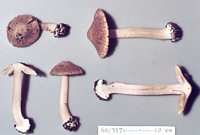
Caption: 68/317: Astrosporina graveolens
Owner: Egon Horak | 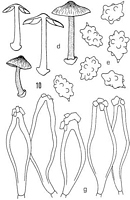
Caption: Astrosporina graveolens (
type ): d, carpophores; e, spores; g, cheilo-and pleurocystidia | 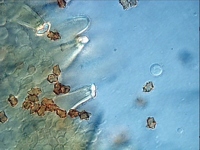
Owner: J.A. Cooper | 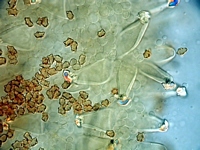
Owner: J.A. Cooper | 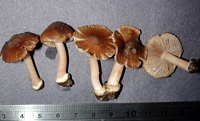
Caption: fruitbodies
Owner: J.A. Cooper | 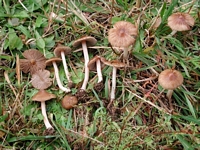
Caption: fruitbody
Owner: J.A. Cooper | 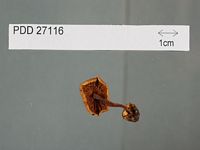
Caption: Dried type specimen
Owner: Herb PDD | 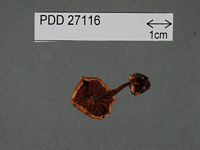
Caption: Dried type specimen
Owner: Herb PDD | |
Article: Horak, E. (1978) [1977]. Fungi Agaricini Novaezelandiae. VI. Inocybe (Fr.) Fr. and Astrosporina Schroeter. New Zealand Journal of Botany 15(4): 713–747 (http://www.rsnz.org/publish/abstracts.php).
Description: Pileus -35 mm diam., hemispherical when young
becoming convex-umbonate to campanulate; beige to light brown, reddish brown
in centre; slightly viscid when wet, innately fibrillose, veil remnants absent.
Lamellae adnate, densely crowded, ventricose; grey turning beige-brownish, edge
paler, fimbriate. Stipe 25-50 x -5 mm, cylindrical, with strongly marginate,
bulbous base (-12 mm diam.); whitish turning reddish brownish; pruinate for
whole length; solid, single in groups; bulb outside white. Context whitish to
light brownish. Odour spermatic.
Spores 10-13 x 7-10 µm, nodulose, with conspicuous
knobs, brown. Basidia 28-35 x 8-9 µm, 4-spored. Cheilo- and pleurocystidia 65-90
x 16-26 µm, fusoid, thick-walled (-4 µm diam.), with yellow-brown plasmatic
pigment, encrusted. Caulocystidia like cheilocystidia but smaller. Cuticle a
cutis of cylindrical hyphae (4-12 µm diam.), encrusted with brown pigment. Clamp
connections numerous.
Habitat: On soil among litter of Leptospermum scoparium
(and Nothofagus cliffortioides). New Zealand.
Notes: In New Zealand this is the only species,
which has a strong spermatic smell. Keyed out with European literature A.
graveolens appears to be closely related to I. pseudohiulca Kuhn.
-Bours. and I. oblectabilis Britzm.
|